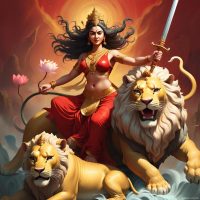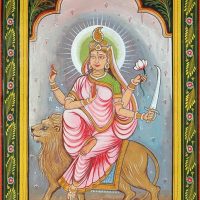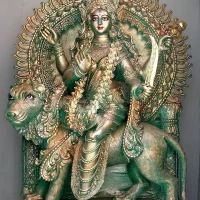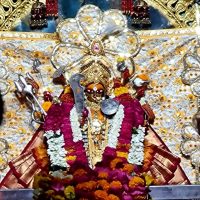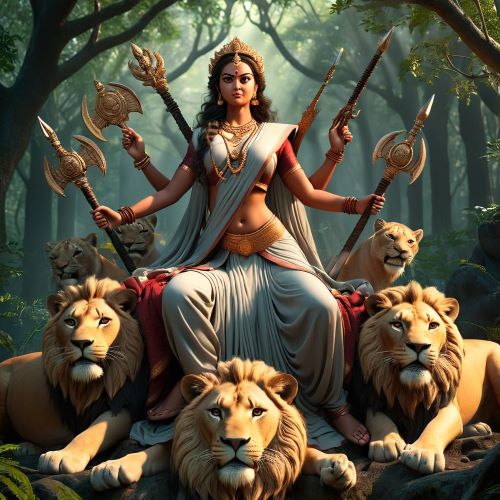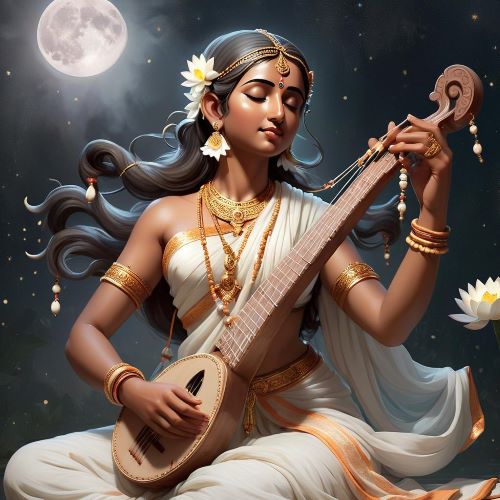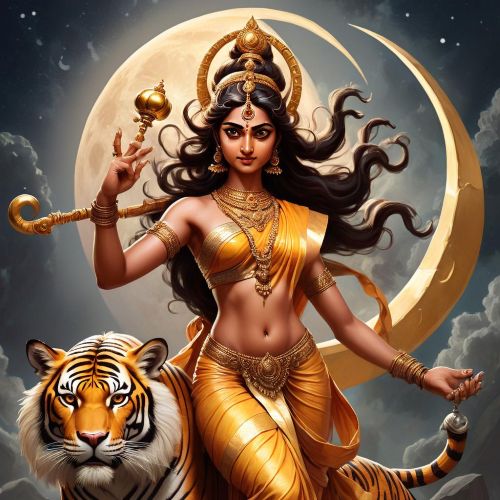Katyayani : The Warrior Goddess
Listen
At a glance
| Description | |
|---|---|
| Origin | Indian Mythology |
| Classification | Gods |
| Family Members | Katyayana (Father) |
| Region | India |
| Associated With | War, Bravery |
Katayani
Introduction
Katyayani (Sanskrit: कात्यायनी) stands as one of the most revered forms of the goddess Durga, worshipped as the sixth manifestation of the Navadurga. Her legend is deeply woven into Shaktism, where she represents divine justice and the destruction of evil forces. Katyayani is celebrated for her pivotal role in defeating the buffalo demon Mahishasura, an act that symbolizes the victory of light over darkness. Worshipped on the sixth day of Navaratri, she embodies both motherly compassion and ferocious strength. Her name originates from Sage Katyayana, in whose hermitage she manifested, earning her the title of his daughter.
Physical Traits
The iconography of Katyayani highlights her role as both protector and warrior. She is depicted with a golden complexion, four arms, and a commanding presence. Mounted on a lion, she radiates courage and authority, reflecting her fearless nature. In her hands, she carries a sword that represents the destruction of ignorance and a lotus symbolizing purity and spiritual awakening. Her remaining hands are raised in Abhaya mudra, offering protection, and Varada mudra, granting blessings to her devotees. Adorned in red garments and celestial ornaments, her form unites beauty with ferocity. Ancient texts like Patanjali’s Mahabhashya mention her association with the color red, a hue linked with energy and power. Some depictions also portray her with three eyes, emphasizing her divine vision that transcends the ordinary.
Family
Katyayani’s origin story connects her to Sage Katyayana, who longed for the goddess to be born as his daughter. His prayers were answered when the gods, threatened by Mahishasura, released their combined energies, which coalesced in his hermitage. This divine energy took form as Katyayani, symbolizing her unique place as a child of both the rishi and the cosmic forces. In other traditions, Katyayani is regarded as a manifestation of Parvati, wife of Shiva and mother of Kartikeya, linking her to the broader family of divine protectors. Her legends also intersect with Krishna’s life. The Bhagavata Purana describes how the gopis of Vrindavan worshipped Katyayani to gain Krishna as their husband, reinforcing her role as a goddess of marital devotion. In regional traditions, she is even venerated as the Kuldevi of the Yadavas, demonstrating her widespread cultural significance.
Other names
Katyayani is worshipped under many names, each reflecting different aspects of her power and persona. She is often called Mahishasuramardini, the slayer of Mahishasura, emphasizing her role as a divine warrior. She is also identified with Chandika and Bhadrakali, fierce forms of the goddess invoked in times of crisis. In Shakta traditions, she is equated with Adishakti Parashakti, the supreme feminine power from whom all existence flows. Southern Indian traditions sometimes connect her to Devi Kanya Kumari, the eternally youthful goddess of purity. These names underline the depth of her character—from a nurturing mother to a relentless destroyer of injustice.
Powers and Abilities
Katyayani’s powers are central to her worship and mythology. Her greatest feat, the slaying of Mahishasura, reveals her as the embodiment of invincible strength. Yet her power extends beyond warfare; she is invoked to remove obstacles in life, whether related to health, prosperity, or spiritual growth. Devotees believe she has the ability to absolve sins, banish negative energies, and provide courage in moments of weakness.
Astrologically, Katyayani governs Mars and Jupiter, planets that symbolize determination, wisdom, and prosperity. In yogic traditions, she is associated with the Ajna chakra—the third eye—which represents intuition and higher consciousness. Meditating on Katyayani at this level is believed to enhance inner clarity and spiritual insight. Her energy transforms material attachment into spiritual vision, guiding seekers toward liberation.
Her powers are also particularly sought in matters of marriage. The Katyayani Vrata, a traditional vow performed by unmarried women, is dedicated to seeking her blessings for a good husband. This practice, followed since ancient times, connects her compassion with human desires for companionship and harmony. In Tantric traditions, invoking her is also believed to bring relief from Manglik dosha, a planetary affliction that affects marital compatibility.
Modern Day Influence
Katyayani’s worship continues to thrive in contemporary times, reflecting her timeless relevance. The sixth day of Navaratri is dedicated to her, with devotees across India performing rituals that honor her courage and seek her blessings for strength and prosperity. Her temples are spread across the country, including the famous Chhatarpur Temple in Delhi, the Sri Katyayani Temple in Cherthala, and the Kumaranalloor Temple in Kerala. Each temple preserves unique traditions while celebrating her as a universal mother.
In Vrindavan, Katyayani is especially honored because of her connection with the gopis’ devotion to Krishna. Pilgrims visit her shrines seeking blessings for marriage and harmony in relationships. Her worship is also integrated into regional festivals. In Tamil Nadu, during Pongal, girls create sand idols of Katyayani and pray for rain, harvest, and prosperity, showing her link to agrarian cycles.
Her cultural impact is not limited to rituals alone. Legends recount that Shivaji, the Maratha king, received a sword from Katyayani for his expeditions, highlighting her historical association with resistance and leadership. In modern discourse, Katyayani is also interpreted as a symbol of empowered femininity. Feminist movements and spiritual reformers draw upon her imagery to emphasize resilience, justice, and the inner strength of women.
In yoga and meditation communities worldwide, her connection to the Ajna chakra has made her a focus of spiritual practices that aim at awakening higher consciousness. In literature, art, and digital media, Katyayani continues to inspire creative expressions, from devotional poetry to contemporary reinterpretations of mythology.
Related Images
Source
Wikipedia contributors. (2023). Katyayani. Wikipedia. https://en.wikipedia.org/wiki/Katyayani
Wisdom Library. (n.d.). Goddess Katyayani: Significance and symbolism. https://www.wisdomlib.org/concept/goddess-katyayani
Shaligram.com. (n.d.). Goddess Katyayani Significance of Katyayani. https://www.shaligram.com/articles/Katyayani.php
Markandeya, R. (ca. 400–500 CE). Devi Mahatmyam, in Markandeya Purana. Translated by various scholars.
Bhattacharyya, N. N. (1999). History of the Tantric Religion. Manohar Publishers.
Kinsley, D. (1988). Hindu Goddesses: Visions of the Divine Feminine in the Hindu Religious Tradition. University of California Press.
Pattanaik, D. (2010). Devi: The Mother-Goddess in Indian Mythology. Inner Traditions.
Frawley, D. (1994). Tantric Yoga and the Wisdom Goddesses. Motilal Banarsidass.
Frequently Asked Questions
What is lorem Ipsum?
I am text block. Click edit button to change this text. Lorem ipsum dolor sit amet, consectetur adipiscing elit. Ut elit tellus, luctus nec ullamcorper mattis, pulvinar dapibus leo.
What is lorem Ipsum?
I am text block. Click edit button to change this text. Lorem ipsum dolor sit amet, consectetur adipiscing elit. Ut elit tellus, luctus nec ullamcorper mattis, pulvinar dapibus leo.
What is lorem Ipsum?
I am text block. Click edit button to change this text. Lorem ipsum dolor sit amet, consectetur adipiscing elit. Ut elit tellus, luctus nec ullamcorper mattis, pulvinar dapibus leo.
What is lorem Ipsum?
I am text block. Click edit button to change this text. Lorem ipsum dolor sit amet, consectetur adipiscing elit. Ut elit tellus, luctus nec ullamcorper mattis, pulvinar dapibus leo.
What is lorem Ipsum?
I am text block. Click edit button to change this text. Lorem ipsum dolor sit amet, consectetur adipiscing elit. Ut elit tellus, luctus nec ullamcorper mattis, pulvinar dapibus leo.


